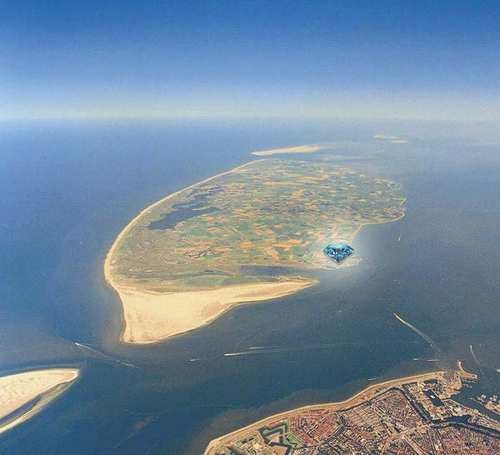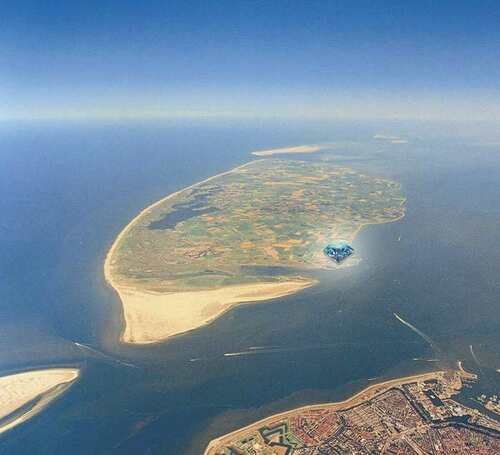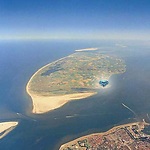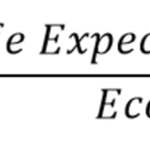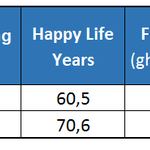The research methodology used to generate the ideas and insights presented in the previous chapters was based on literature review, news and interviews with experts related to sustainability transitions and initiatives. The final stage of the process included on-site research: experiencing and having contact with Texel and its people. For the sub-system of Health, Happiness and Well-being, it represented an opportunity to test assumptions, to improve the concept for the proposal and to look for possible facilitators for the sub-system’s proper functioning.
The on-site research aimed at exploring the current environment and possibilities for implementing the proposal and at providing an initial and raw measurement of the current state of the sub-system. Moreover, it was divided into two main parts:
- Interviewing Texelaars regarding our proposal and their vision of the sub-system
- Performing a value survey focused on measuring life satisfaction, satisfaction with sustainable behaviors and importance given to sustainability values.
The Texelaars interviewed included entrepreneurs (Peter Koorn and Michel Gregoire), social innovators (Peter Kieft and Luciette van Hezik), and a representative of the local municipality related to sustainability (Pieter de Vries). The survey was performed at the city center of Den Burg using a quota sample of 30 inhabitants (15 man and 15 woman of different age groups) in order to ensure some representativeness to the exploratory work. The results presented in this chapter are indications of the current state and not an exact measurement, a properly structured research needs to be executed in order to test the statistical significance of the relations and results presented. For more information regarding the survey content, the reader is referred to the Appendix 1.
The main results of the interviewing process were related to the discovery of new challenges regarding the proposal’s implementation and usefulness for the island, this topic will be discussed further in the next section. Regarding the survey, it was found that life satisfaction is quite high among inhabitants with a value of eight based on a scale of one (worst possible life) to ten (best possible life).
However, this satisfaction does not seem to be related to their satisfaction with sustainable behaviors. According to the criteria proposed for the sub-system, it was asked to respondents to grade the level of satisfaction they feel with behaviors related to each criterion. The indicators with higher level of satisfaction were the amount of nature, the current state of the nature and the amount of tourists visiting the island; and the ones with lower level were exodus of young people, availability of facilities to apply or buy green energy and education opportunities for young people. Finally, the respondents graded the level of importance given to sustainability values, for Texelaars the most important ones are air quality and maintenance of nature.
General results confirm the assumptions made before regarding the value Texelaars give to the green environment of the island, and the relevance that tourism have for the islanders’ life quality. Furthermore, the life satisfaction level is a clear indicator of the overall social cohesion, Texelaars pride to be islanders and the good conditions provided by the island to make a living. However, such high level has the potential to become a bottleneck when proposing a transition towards sustainable behaviors because people already feel happy and satisfied with their current lifestyle and a strong incentive will be required to change the current inertia. On the other hand, it was confirmed the importance that young people’s future has for the islanders, and their concern for the opportunities available for young people to develop personal and professional skills for the benefit of the island. Finally, there are still challenges related to the transition to green energy and the satisfaction of Texelaars with their access to such service.
Furthermore, in order to complete the current state analysis of the Happy Texel Index, a raw calculation was made based on available information. The happy Planet Index is based on three criteria: life expectancy, life satisfaction and ecological footprint. As there is no data for Texel individually, the life expectancy of the Netherlands (80,7 years) was taken as a basis. In addition, calculations for the ecological footprint of Texel’s population would require a considerable high amount of data regarding the consumption patterns of inhabitants and the production cycle of the goods and services provided in the island. Consequently, an estimation was made for the ecological footprint of Texel taking as reference the value for the Netherlands and the differences in land use and population of the island compared with national levels.
Table 1 shows the result of the HPI calculations for Texel and the HPI reported results for the Netherlands (HPI, 2015). It can be seen that Texel has a higher result than the national average; however, it is still far from the goal of 89 proposed by the creators of the HPI based on reasonable levels for the criteria used for the calculations. In order for Texel to achieve such goal, it must focus on creating the necessary well-being to increase life expectancy and life satisfaction, and taking measures to decrease its ecological footprint by at least 60%.
Table 1. HPI calculations: comparison between Texel and the Netherlands
In addition, the analysis of the values related to sustainability was done comparing age groups: young (-30 years old), middle aged and elderly (60+ years old). Figure 1, Figure 2 and Figure 3 show the results of the value assessment for each group age, each figure represent a measurement related to sustainability and the values reflect the importance each group gives to the specific value. The color scale goes from dark green (high) to red (low). The criteria are presented in the next order: life satisfaction, transition to sustainable/renewable energy, reduction of CO2 emissions, maintenance of nature, air quality, saving food product, saving energy, saving water, availability of local products, taking actions to be sustainable and HTI score.
Figure 1. Value assessment for young people
Figure 2. Value assessment for middle-aged people
Figure 3. Value assessment for elderly people
Even though the overall life satisfaction is high, there are differences among groups. The group with highest life satisfaction is the middle-aged and the least satisfied are the elderly, results reflected in the same order by the HTI. On the other hand, there is a lack of importance given to the value of taking action to be sustainable, with the middle-age people having the highest interest. This situation, added to the current high life satisfaction level, increase the challenge of starting a movement towards becoming a more sustainable society. Finally, the age group giving more importance to sustainable values are the elderly and the ones giving the less importance are the young people. This fact increases the complexity of young people circumstances in the island and the importance of focusing on shaping the values of this generation towards more sustainable ones in order to achieve and sustain Texel’s sustainability goals.
In conclusion, the previous analysis confirmed and confronted the assumptions used for the previous design and provided new insights on challenges to face during the transition. Consequently, this chapter is going to be focused on improving the concept of the subsystem’s proposal taking into consideration the information gathered, the main focus will be the how to make the transition happen in order for the proposal to be useful for the Texelaars.
Design
As mentioned in the previous paragraphs the current Happy Texel Index appears to be surprisingly low, while the people of Texel are very satisfied with the way they live. This poses the question: How can we increase the Happy Texel Index while maintaining the current life satisfaction?
According to the HTI equation, The Happy Texel Index is related to life expectancy and ecological footprint. The current life expectancy on Texel is quite high (see Appendix 1) so the factor that needs to be lowered is the Ecological Footprint.
What lies at the basis of the challenge to decrease the ecological footprint, is the values the people of Texel give to sustainability. As mentioned in Chapter 4, values people have towards sustainability are strongly related to their knowledge on how their behavior influences their surrounding environment, for example, on how saving energy will decrease their carbon footprint. This means the key to make the transition to become a self-sufficient island is to educate people about the consequences of their actions, fact that is reflected in The Happy Texel Index.
The next step is how to implement the Happy Texel Index so it will be visible to the public. According to Pieter de Vries , a Policyworker on the department of Sustainable Development at the Municipality of Texel, the HTI could be a vital part of the 2020 goals. The municipality, however, appeared to be reluctant to facilitate the measuring and the guarding of the HTI because of the high life satisfaction which is already there.
“Why should we push our inhabitants to live differently if they are already happy?”
This confirmed the idea, that the municipality of Texel would not be the driver of the HTI. The municipality will support but not facilitate.
Because HTI monitors the effects of the other sub-systems, it is needed that the HTI will be measured and guarded by one organization. An organization, to which the people of Texel can come for consults on how to run or start their sustainable business. Initially a HTI advisor will be appointed to accurately measure the current index. Afterwards, the index and its influencing factors will be made visible on the website of this organization. As a first insight the texelgeeftenergie.nl website could be a good start for this.
In the future system the Happy Texel Index will have a monitoring role over the other sub-system. It will assess the behavior of the people of Texel but it will also be able to foresee unsustainability mechanism. In this way, sustainable entrepreneurs who want to start a business will know what kind of market value their business will have and how much it will contribute to the sustainable goals of Texel for 2020. Part of the design is to host the HTI consultation in an Innovation Centre, which incorporates an incubator and a science lab. This Innovation Centre is the connection of the Knowledge Route, the Waste and Water cycles. It is the place where all the sustainability mechanisms come together. A place where people work together to make profit by being innovative to create more jobs for young people. Located in the harbor, it will be the jewel of the Island. Visible from “the other side”, it will function as a showcase of the technological and social development Texel is undergoing. Revealing to the world how Texel is leading in sustainability.
Possible implementation
To implement the Happy Texel Index the sub-system needs an initiative which can use the HTI to benefit their goals. After having talked to several people, the EcoHof Texel, appeared to be an initiative that has the same view on sustainability alonside well-being of the people. This is their story.
“Our main goal is to be an example for sustainable lifestyle. We do not only want to create only ecological houses but also want to stimulate social interaction. For example when you are in a big school you don’t know each other. But by scaling down, we can create freedom in connection.
In an interaction, energy is exchanged, when I give my high energy to people with low energy it will influence their immune system. When somebody is out of the circle, he will become ill. It is both a spiritual and a physical approach.
Texel is an island, and on an island there is always more interaction. However, what happens on Texel is a more superficial interaction. People talk about each other without having a profound interest in one another.
Getting started
Everyone will have their own house, and there will be a shared space where people come together. The composition of the houses will be circular, where the center is the communal area. But not only the houses, but also the material we use will benefit well-being of the inhabitants, this means we want to focus on bio materials such as straw and wood. We expect that after the realization of the project, it will start growing very fast, because people appreciate living in a more social and natural environment.
Social strength
The essence of such a community is to provide the opportunity for people to speak their heart. When a person is bothered with something he can step up and talk to people about his problem. It is called a ‘forum’, in a group this person will say everything that he is feeling. The others don’t say or ask anything, so this person can say anything he wants. Afterwards the others in the community tell him what they heard and what they have seen they to give a reflection. After that they will know what needs to be changed. At this moment when people share their issues with others, they are being told to act in a certain way, they will be comforted to make the issue feel less bad or people start talking about their own experiences regarding this situation. By changing the way we interact, people feel heard and people feel understood. People feel safe to share their irritation, so people will talk with each other. And it will prevent people from talking behind each others backs.
Well-being and sustainability
We want to focus on the education on a sustainable lifestyle. The young can inspire the elderly and the elderly can in turn inspire the young people. Eventually the sustainable lifestyle will become a habit. People need to change, and we want to be an example for them to make the transition happen. On Texel there are already so much initiatives, take Lets Texel for instance, it is a Local Economic Transition System. When I buy something I don’t need anymore I can give it to someone else and pay in money or in “Boetjes” which is equal to a euro. In this way, it becomes a trading system of a product. Although this is digital, it shows that the people on Texel already are thinking in the right way.
Our idea is to build a test environment where people could rent a house for a month or a week at the EcoHof, here they can experience for themselves what it will be like to live a more sustainable lifestyle. At this location, the HTI could be applied so people can see how their actions have an influence on the index. Because the people on Texel are willing to change but the transition towards taking action remains a difficult one. This test environment will make this transition a lot easier, because people will experience what a nice environment they can live in and can decide for themselves that they want this as well. Luckily, the people of Texel already value living in and with nature, because that is mostly the reason people come to Texel. In the end, the goal is to provide the area with its own energy and water supply.
Essentially, what we can do is, offer an example for a change in a sustainable lifestyle, living environment and expenditure. In that way, we see that the Happy Texel Index can grow from 50 to 70. So the Happy Texel Index can really contribute to revealing the importance of our design to the public. We really like how the different generations are addressed and how the index shows what core sustainability values need to be addressed.
The proposed Innovation Centre also really appeals to us because it is needed to catch peoples attention right away, when entering the island. This place could really be a starting point for us to set up workshop for young and old and to get started with the HTI.” – Luciette van Hezik and Peter Kieft (www.ecohoftexel.nl)
Subsystem connections within the proposals of the future subsystems.
As our specific sub-system of Health and Happiness is the only one directly addressing people, their lifestyle and their perception of life, it was concluded that its main contribution has to be related to the society transition towards more sustainable values. These values are related to facilities, which are in turn related to the other subsystems. Our connections to these subsystems are therefore important to examine.
- Food and more: The connection to this subsystem is related to the production of healthy (organic) food, and the promotion among Texelaars of local products’ consumption. Healthy foods contribute to a person's health, whilst the consumption of local products could become more of an experience resulting in added value for food consumption for Texelaars (due to pride) and tourists (due to trying local products). This subsystem could therefore influence ones happiness and one's health by promoting a healthy lifestyle.
- Leisure and knowledge: The leisure and knowledge subsystem is very much related to the combination of the two themes; leisure and knowledge. By means of a TexelLab, the idea is to expose creative ideas related to sustainability. Since this could also be seen as a leisure will result in a leisure activity accompanied with more jobs. The second idea is to decrease the ecological footprint of tourism by providing this knowledge to the tourists. This is also related to the TexelLab, which in our proposal, is also an empowerment platform. For our subsystem, this means that this subsystem will be connected to the empowerment platform as well as the Happy Texel Index. The system is focused on
- Materials and waste: The subsystem of materials and waste is especially connected to our subsystem through the ecological footprint, and therefore also the Happy Texel Index. The proposal of a sustainable and efficient waste management system does not only contribute to reducing the ecological footprint, but also be a catalyst for new innovations related to waste. These would then be able to enjoy help from the empowerment platform.
- Public space: The public space future subsystem focuses on supporting of all the other subsystems. The strategy is to integrate the subsystems, support them, connect them and promote them. Thus, promoting the identity of Texel and further increasing the strong identity of the Texelaars. This could have a significant impact towards life satisfaction for the Texelaars, thus having a positive effect on the Happy Texel Index.
- Sustainable mobility: The subsystem of sustainable mobility is related to the way that the inhabitants and visitors of Texel are transported around the island. Electric cars influence the ecological footprint and are mostly focused on the tourists during peak holiday weeks. Within these peak weeks, the amount of fossil fuels used in transport will then be reduced. Happiness and life expectancy will most likely not be affected by the change in transport. These forms of sustainable mobility can however have an impact on the ecological footprint.
- Texel as host: This subsystem is all about creating awareness under the tourists. The aim of the system is to have its effect on the ecological footprint of tourists visiting Texel. The developments in this subsystem can have a positive impact in the transition towards healthier and more sustainable lifestyles among inhabitants, and can be used to promote such values among visitors by means of E.G. locally produced biological foods. Since this subsystem also focuses on awareness, it will result in more awareness for tourists, by which the ecological footprint of the tourists will shrink eventually.
- Water cycle: The water cycle is connected to the Happy Texel Index through its influence on Ecological footprint as well as Life quality. Since it is not feasible to aim for a fully self-sufficient water system, the focus of the system has shifted towards water management. This means that the sub-system; Water Cycle has less of an impact towards the ecological footprint as previously assumed, since the impact has slightly shifted towards life quality. Nevertheless, the subsystem Water Cycle will probably have a significant influence ecological footprint, and therefore also on the Happy Texel Index.
HPI (2015). Happy Planet Index: the data. Retrieved on January 15 2015, from: http://www.happyplanetindex.org/data/
